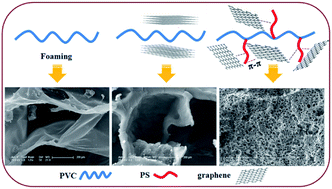Effect of polystyrene long branch chains on melt behavior and foaming performance of poly(vinyl chloride)/graphene nanocomposites†
Abstract
Several poly(vinyl chloride)-g-polystyrene graft copolymers (PVC-g-PS) with well defined molecular structures were synthesized via atom transfer radical polymerization (ATRP) from the structural defects of PVC. The effects of PS branch chains on the shear and extensional rheology as well as foaming properties were investigated. Compared to linear PVC, the introduction of PS branches results in increased complex viscosity, an elevated value of storage modulus at low shear frequencies, more pronounced shear-thinning behavior, more significant upshifted deviation from linear behaviour and a strain hardening phenomenon. Under the same foaming conditions, most of the resulting PVC-g-PS foams exhibit a closed cell structure, increased cell density and uniform cell size distribution while the linear PVC foam has serious cell coalescence. Moreover, graphene nanosheets could be well dispersed in the PVC-g-PS matrix due to the π–π stacking with PS relative to the PVC without PS branch chains. As expected, both the nucleation effect and increased melt viscosity from well-dispersed graphene sheets significantly improve the foaming behavior of PVC-g-PS/graphene nanocomposites, in comparison with the poor foamability of PVC/graphene composites due to the non-uniform dispersion of graphene.


 Please wait while we load your content...
Please wait while we load your content...